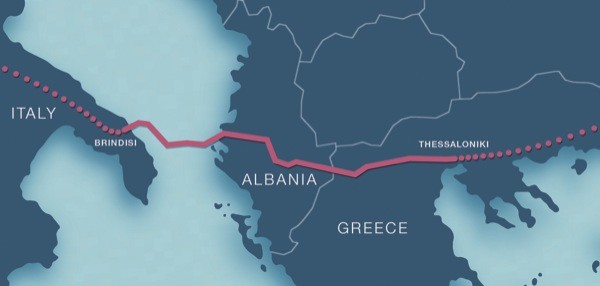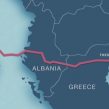
Interconnector and Trans-Adriatic Gas Pipeline Projects: How Competitive?
Publication: Eurasia Daily Monitor Volume: 8 Issue: 10
By:

The Interconnector Turkey-Greece-Italy (ITGI) is a project of the Milano-based Edison with Depa, the Greek state-controlled gas transmission and trading company. ITGI proposes to carry 10 to 12 billion cubic meters (bcm) of “Caspian” gas per year, including 8 bcm to Italy and the remainder for Greece. The primary goal is to supply Edison’s electricity-generating plants in Italy with gas. Milano with other northern Italian municipalities, as well as (indirectly) Electricite de France, are Edison’s main shareholders. ITGI’s target date for completion is closely correlated with that of Shah Deniz project’s Phase Two of gas production in Azerbaijan. That production, however, is existential to the Nabucco pipeline project (EDM, January 12, 13).
ITGI would use Turkey’s pre-existing transmission pipelines for 1,700 kilometers, east-west across that country. A Turkey-Greece Interconnector of 300 kilometers (km) was added in 2007 by the two state pipeline operators, Botas and Desfa (Depa’s subsidiary). The remaining missing link is a Greece-Italy Interconnector. This would run for almost 600 km overland across Greece (to be developed by Desfa), and slightly over 200 km on the seabed of the Ionian Sea to Otranto in Italy (the Poseidon line, an Edison-Depa venture) (www.edison.it; www.depa.gr; www.igi-poseidon.com; European Energy Review, January 6).
The Trans-Adriatic Pipeline (TAP) is a project of Norway’s state-owned Statoil, the Swiss Elektrizitaet Gesellschaft Laufenburg (EGL), and the German E.ON Ruhrgas, with stakes respectively of 42.5 percent, 42.5 percent, and 15 percent in the project company. TAP proposes to carry 10 bcm of “Caspian” gas per year in a first stage, and 20 bcm in a second stage (by adding compressor capacity). The first-stage goal is to supply gas for EGL’s power plants in Italy and Switzerland. TAP’s target date for completion is (like ITGI’s) closely correlated with that of Shah Deniz project’s Phase Two of production in Azerbaijan, although this is existential to Nabucco.
TAP would (like ITGI) use Turkey’s pre-existing transmission pipelines running the full length of that country from Erzurum to the Greek border. It proposes to build a new, 520 kilometer pipeline overland from Thessaloniki in Greece to Albania’s Adriatic coast, continuing with a 115 kilometer line on the seabed of the Adriatic Sea to Brindisi in Italy (this segment’s designation being extrapolated to the overall project). The elevations profile is especially challenging, with its highest elevation point at 1,800 meters in Albania’s mountains, and its lowest section 820 meters deep on the seabed (https://www.trans-adriatic-pipeline.com; www.statoil.com; www.egl.eu; European Energy Review, January 3).
When examined as commercial projects in their own right (irrespective of strategic considerations and European priorities) TAP and the Greece-Italy Interconnector display serious weaknesses. These include shared weaknesses and project-specific ones. Both projects require transportation of Caspian (in practice, Azerbaijani) gas through Turkey’s pipeline grid, before that gas would reach the proposed pipelines in Greece and/or Albania en route to Italy. However, certain sections of Turkey’s grid would require substantial upgrades for enhancing capacity and removing bottlenecks, so as to accommodate the additional transit volumes for these two projects. For example, the bottleneck between Sivas and Ankara poses special problems even before the gas flow reaches Turkey’s main centers of consumption, without factoring in any future additional volumes for other countries.
Furthermore, the TAP and Greece-Italy Interconnector project companies would have to lease pipeline capacities from Botas along most of the east-west distance on Turkish territory. Upgrades, capacity expanding measures, and leasing would involve major additions to investment and operating costs. Without factoring in those costs, claiming a cost advantage for these projects is an over-optimistic picture.
Each of these two projects lacks a uniform transit regime across the countries involved. The transit regimes would have to be negotiated separately in each case, within differing regulatory environments, facing potential transit risks and problems. The Turkish government and Botas have a track record of stonewalling in negotiations. The Nabucco consortium, however, plans to build its own pipeline on Turkish territory; and it enjoys a uniform legal regime in all participant countries, guaranteed under the 2009 inter-governmental agreement.
The tripartite ITGI project agreement, signed in 2007, entitles Turkey to a 15 percent lift-off from the gas flow, at the expense of the other ITGI partners. The Nabucco project had faced the same Turkish demand, incompatible with EU norms. But the Nabucco consortium, backed by the EU Commission, ruled out any lift-off in the signed agreement.
EU financial backing for ITGI construction seems unlikely in the near future, or as long as the project competes against Nabucco over Azerbaijani gas. Greece needs an international bailout even without undertaking this massive infrastructure project on its territory. Whether Edison’s stakeholding Italian municipalities can correspondingly finance this project is doubtful. Edison’s other major (indirect) shareholder, Electricite de France, must manage its own debt portfolio, and is meanwhile negotiating to join Gazprom’s South Stream project.
TAP (unlike Nabucco) is not closely linked with the European Union, and thus it is not a frontrunner for EU financial backing of construction work. TAP’s founding and dominant stakeholders are in the non-EU countries Norway and Switzerland. The consortium has selected another non-EU country, Albania, for planned storage of Caspian (i.e., Azerbaijani) gas, instead of storage on EU territory. TAP’s minority shareholder E.ON Ruhrgas is a recent add-on, for a foothold in the EU; but this does not significantly change that picture. For these reasons, and considering TAP’s rivalry with Nabucco, the EU seems unlikely to finance TAP construction work (feasibility studies and limited technical assistance is a different matter). Evidently aware of this, Statoil (the main driving force in TAP) is now publicly coming out in Brussels against EU financial backing for Nabucco’s construction. Statoil wants a “level playing field” for these projects in the EU (European Energy Review, January 3).
Indeed, the EU Commission is mobilizing financial backing for Nabucco. A “level playing field” as urged by Statoil would mean either withholding such backing from Nabucco, or dividing any financial support between Nabucco and the rival projects. In the existing circumstances, Statoil’s proposal amounts to a Nabucco-stopper, for the sake of one or two non-strategic projects, and without necessarily addressing their inherent problems. The ITGI and TAP could, however, find their raison d’etre as Southern Corridor components, once Nabucco opens the way for Central Asian and Middle Eastern gas to Europe.




